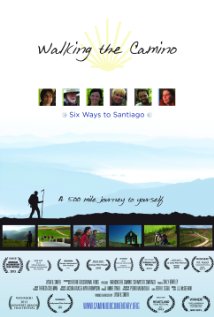
WALKING THE CAMINO: SIX WAYS TO SANTIAGO
US, 2013, 86 minutes, Colour.
Directed by Lydia Smith.
Many people, Catholics, Christians, people of other faiths, or professing no faith, have toyed with the idea of walking the Camino. For those who saw Emilio Estevez’s film with his father, Martin Sheen, The Way, a group of fictitious characters walking the period pilgrimage to Santiago de Compostela, the idea might have been reinforced. There is every possibility that those who watch this documentary will be fascinated, again wondering if they should…
On the other hand, audiences who watch the film, in the comfort of the cinema or in a lounge chair at home, might well feel that they have actually made the Camino and now they won’t have to leave home, but, maybe, will watch the documentary again.
The director, Lydia Smith, joined a number of pilgrims at the starting point at St Jean Pied de Port in France, approaching the Pyrenees. It is by chance, or by providence, that these individuals start their walk at the same time, progress over 30 or more days, meeting each other, talking or sharing silence, reflecting on their lives, their prayer and God’s role in their lives, enjoying the mixture of accommodations along the way, becoming friends – allowing themselves to be photographed, at their best as well is in some of their pain, and sharing many of their views to camera.
In this way, the audience in those comfortable chairs, shares in the experience of what happens in the Camino, meeting the different pilgrims, getting to know them, to like them, like some very much, enjoying their company, anxious for them at times, but eager to learn more and more about what the experience of the pilgrimage means to them.
One of the main attractions is that the photography of quite a range of terrains, mountains and plains (with somebody even mentioning where the rain in Spain stays), villages with the touch of the mediaeval, cities with magnificent cathedrals, the gamut of vistas along the top of northern Spain. Somebody mentions that it is like walking through postcards.
Some of the pilgrims include a young articulate man from Portugal, very genial, always a pleasure to hear what he has to say and how he is found the Camino. On the other hand, there is a mother with her three-year-old son, who confides to camera that the reason he is on the Camino is that he had no choice! She is travelling with her brother, who enjoys company and partying and has no faith and who does not seem to benefit much from the experience. It should be said that the mother walks these hundreds of kilometres, mostly pushing her son in his pram. There is an elderly American widower and an elderly friend from Canada (who gives the impression that he could be a priest). There is a girl from Denmark who is befriended by William from America. They help each other and it is they, for the purpose of the film, who travel the extra 80 km west to the Atlantic, to Finisterre, where in those days it was a fitting conclusion to the Camino because it was considered to be the end of the flat world.
The film is not heavy on ecclesiastical interventions. Throughout the film, several clerics do give explanations about St James, Santiago, the discovery of his tomb, the centuries-old pilgrimage, prayer, faith, the scrutiny of one’s life, one of the pilgrims even referring to the experience as an internal Camino. Some of the pilgrims remark that they are confused by what may be beyond the visible, that there may actually be something beyond, but simply walking this day as best they can is the best they can do. Life and spirituality are intertwined.
In case anybody is still toying with the idea of actually going, there are scenes of the Alburges, the hotels, or hostels, available the pilgrims after they have had their documents stamped and can get a meal, have a sleep in close, very close dormitory style, helped by a number of volunteers who are of great assistance to the pilgrims. Somebody mentions snoring! And, there are many sore feet, and we see a range of blisters.
There are rituals on the way, including some of the pilgrims experiencing a washing of the feet, in the vein of the Last Supper.
Some of the remarks by the pilgrims including those nuggets of wisdom: the Camino is a simple existence which is somewhat addictive; being close with the pilgrims is a kind of cohabitation, without any competitiveness; it is walking and the people you meet, with happiness meant to be shared.
This is not an overlong documentary, is audience-friendly, communicates a great deal of what the Camino is about and a great deal of what happens and what can happen along the way. While the theme is spiritual, the film communicates a great deal of ordinary and welcome humanity.